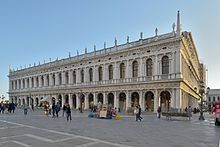Jacopo Sansovino

Jacopo Sansovino (actually Jacopo Tatti or Jacopo d'Antonio Tatti , born July 2, 1486 in Florence , † November 27, 1570 in Venice ) was an Italian sculptor and architect of the Renaissance .
Life
Florence and Rome 1486–1527
Sansovino was born in Florence as the son of a mattress maker. Around 1501 he entered the workshop of Andrea Sansovino , whose name he later adopted. Around 1506 he went to Rome at the invitation of Giuliano da Sangallo , where he met Bramante and Raffael . Sangallo employed him as an employee on the work on the Belvedere of the Vatican. In Rome he worked primarily as a sculptor and restorer of ancient statues. In 1511 he returned to Florence. There he took part in the competition for a figure intended for the Mercato nuovo , but without receiving the order. His first important Florentine work was a statue of St. James for the Florence Cathedral and a statue of Bacchus for Giovanni Bartolini.
In 1515 Leo X , Pope of the Medici family , was solemnly received in Florence. Like many other Florentine artists, Sansovino was involved in the festive decorations for the occasion. When the Pope announced a competition for the design of the facade of San Lorenzo , which has been left raw to this day , Sansovino lost to Michelangelo .
From 1518 to 1527 Sansovino stayed again in Rome, where he worked as an architect in addition to his work as a sculptor. The designs for the churches of San Giovanni dei Fiorentini and San Marcello al Corso date from this period . As a result of the Sacco di Roma , the sack of Rome by the troops of Emperor Charles V , the construction of San Marcello was canceled and Sansovino, like many of his colleagues, fled Rome. On his trip to France he stopped in Venice , which he never left until the end of his life, except for a visit to his hometown of Florence in 1540.
Venice 1527–1570
On the recommendation of Cardinal Grimani , in 1527 the Doge Andrea Gritti commissioned him to restore the main dome of San Marco . Just two years later it became a proto , i.e. H. appointed chief builder at San Marco. He redesigned the choir with two pulpits. In the same year he began with the extensive redesign of the market square: redesign and completion of the old procuraties , new construction of the Zecca , the Loggetta del Campanile and the Biblioteca Marciana (Libreria di San Marco). The vault of a room in the Libreria collapsed, which earned Sansovino a stay in prison. At the same time he received numerous orders for sculptures and reliefs, mainly made of bronze, which were carried out in his large workshop.
Through his friendship with Aretino and with Titian he gained access to the Venetian patriciate. Sansovino was the most highly regarded and influential architect and sculptor in Venice until his death.
Works
buildings

- Redesign of the Piazza and the Piazzetta in Venice with
- Libreria di San Marco in the piazzetta, begun by Sansovino in 1536, completed by Vincenzo Scamozzi in 1583
- Zecca , the coin of Venice, built 1537–1554
- Loggetta at the foot of the Campanile, built 1537–1540
- Old procuraties , from 1532 continuation and completion of the construction of Buon and Grigi by Sansovino
- San Geminiano , Sansovinos grave, demolished in 1807 under Napoleon
- San Francesco della Vigna in Venice, 1534, church building by Sansovino, facade 1568–1572 by Palladio
- San Zulian in Venice, 1553–1554, renovation of the building and design of the facade by Sansovino
- Villa Garzoni in Pontecasale, around 1530
- Facade for the Palazzo Corner , called Ca 'Grande, before 1561
- Tomb for the Doge Francesco Venier , 1555 to 1560, in the Church of San Salvatore in Venice
- Palazzo Strozzi Gaddi Niccolini (controversial)
Sculptures
- Sacristy door of San Marco , bronze relief . 1546–1553, installation 1572. The theme is the Entombment and Resurrection of Christ
- The two giants , (also Mars and Neptune); Marble, placed on the Scala dei Giganti staircase in the courtyard of the Doge's Palace
- Madonna del Parto , Sant'Agostino , Rome
- John the Baptist , Frari Church , Venice
- Sacra Conversazione , relief; Tone in white frame; partly gold and painting; 1530; Bode Museum Berlin
literature
- Joachim Poeschke : The sculpture of the Renaissance in Italy. Volume 2: Michelangelo and his time. Hirmer, Munich 1992, ISBN 3-7774-5430-3 .
- Deborah Howard: Jacopo Sansovino. Architecture and Patronage in Renaissance Venice. 2nd printing, with corrections. Yale University Press, New Haven CT et al. 1987, ISBN 0-300-01891-6 .
Web links
- Literature by and about Jacopo Sansovino in the catalog of the German National Library
Individual evidence
- ^ The architect Jacopo Sansovino and the Loggetta from 1540 in Venice. In: André Chahil | Gallery & Art Consulting. June 20, 2016, accessed June 21, 2016 .
- ↑ Section dedicated to Sansovino's sculptures (basilicasanmarco.it, English) accessed on December 23, 2012
| personal data | |
|---|---|
| SURNAME | Sansovino, Jacopo |
| ALTERNATIVE NAMES | Jacopo Tatti |
| BRIEF DESCRIPTION | Florentine sculptor and architect |
| DATE OF BIRTH | July 2, 1486 |
| PLACE OF BIRTH | Florence |
| DATE OF DEATH | November 27, 1570 |
| Place of death | Venice |


